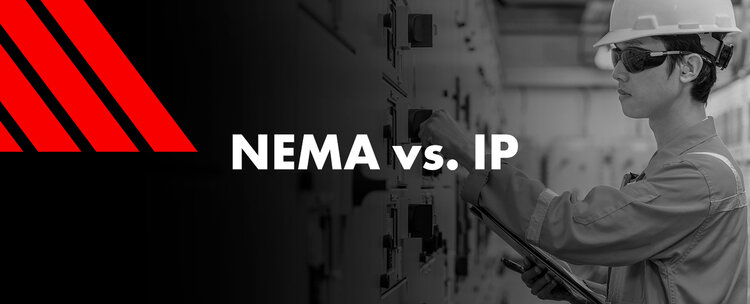Protecting the vital components inside electrical cabinets starts with choosing an enclosure designed to withstand the environmental conditions it will experience. However, when finding ratings, two main types of systems exist. These regulations have slightly different standards within their guidelines. Knowing how to compare Ingress Protection (IP) vs. National Electrical Manufacturers Association (NEMA) enclosure ratings will make it possible to buy an electrical cabinet suited to the location’s needs.
NEMA vs. IP
NEMA sets the standards for electrical products sold in the United States. NEMA standards for electrical enclosures have numeric values, occasionally accompanied by a letter. The specific alpha-numeric combination determines the NEMA rating for the product that corresponds to the kind of environmental hazards the cabinet must protect its interior from.
IP standards for enclosures are the international guideline. They come from the European Committee for Electrotechnical Standardization (CENELEC). While some American manufacturers may offer their products’ IP ratings, this typically appears on electrical cabinets made outside the United States.
These standards both describe the conditions for using an electrical cabinet, but they are not the same. When conducting an IP NEMA rating comparison, the task becomes difficult because each set of standards measures different parameters. For instance, the three numbers in IP standards indicate the type of protection against solids, liquids and mechanical impacts. Higher values for each indicate a more robust cabinet.
NEMA standards describe the environment where the cabinet sits and which elements it protects against. A NEMA 3R vs. IP would indicate different conditions. The 3R rating means the interior has protection against dust, rain, ice, snow and accidental contact with electrical parts. This rating roughly equals an IP14, which protects against solid objects up to 50 millimeters in size and water entry from any side.
NEMA vs. IP Ratings
When using an NEMA vs. IP cross reference table to compare, keep in mind that the two standards differ significantly. While close, the equivalencies in a NEMA vs. IP chart should be used as a guide rather than a rule. Here are some NEMA ratings with their closest comparisons of IP ratings:
| NEMA Ratings | IP Ratings |
|---|---|
| NEMA 1: Protects indoors for general | IP10: Keeps out solid objects such as hands |
| NEMA 2: Provides drip-proofing for indoor use | IP11: Keeps out solid objects like hands and protects against condensation |
| NEMA 3: Protects against sleet, rain and dust for outdoor use | IP54: Protects against dust and water ingress from all sides |
| NEMA 3R: Offers protection for outdoor use when sleet resistance and a rain-tight seal are essential | IP14: Prevents solid objects up to 50 millimeters from touching the interior and protects against water spray from all sides |
| NEMA 3S: Offers dust-, rain- and sleet-tight protection for outdoors | IP54: Protects against limited dust and water ingress |
| NEMA 4: Is best for indoor and outdoor use and offers dust-tight, watertight and sleet-resistant protection | IP56: Prevents harmful dust accumulation from ingress |
| NEMA 4X: Provides all the protection of the NEMA 4 rating, plus corrosion resistance for indoor and outdoor use | IP56: Protects against dust from getting inside and causing harmful buildup |
| NEMA 5: Offers indoor-only protection against dust and dripping | IP52: Prevents water sprays up to 15 degrees from the vertical from entering the cabinet and safeguards against harmful dust accumulation inside |
| NEMA 6: Provides protection inside and out and may have occasional water submersion — also sleet-resistant and completely watertight | IP67: Gives complete protection against any dust entering and can maintain operation with submersion between 15 cm (0.49 ft) and 1 meter (3.3 ft) |
| NEMA 6P: Has same characteristics as NEMA 6 rating but can stay submerged longer | IP67: Lends total protection against water damage from submersion up to 1 meter (3.3 ft) and from dust ingress |
| NEMA 12: Protects against dripping or dust for indoor use only | IP52: Prevents both dust ingress and vertically entering water sprays |
| NEMA 12K: Is suitable for indoor use only with knockouts and protects against dust and drips | IP52: Stops vertical water and dust from entering |
| NEMA 13: Is dust-tight and oil tight for indoor use only | IP54: Prevents dust accumulation inside and protects against water spray from any direction |
NEMA Enclosure Ratings

NEMA enclosure ratings offer manufacturers a way to showcase the various environments and conditions from which their cabinets can protect electrical interiors. As the table shows, the NEMA ratings indicate indoor or outdoor use. Ratings 1 through 6, 12 and 13 have applications in nonhazardous areas. Enclosures with ratings of 7 through 10 have specific hazardous location uses, such as in medical care, mines or locations with potentially explosive substances nearby.
To use NEMA ratings appropriately, consider the enclosure’s location and the environmental conditions the interior needs protection from. Use these criteria to find the best rating for an enclosure’s use.
Some of the most popular options are cabinets with NEMA ratings of 3 or 4 because they accommodate outdoor applications and can withstand multiple weather types. Type 3R enclosures offer good general outdoor protection from rain and sleet. In the Northeastern United States, where the weather can change unpredictably, such security is required for any outdoor electrical equipment and housing.
However, for more comprehensive protection that can work inside or out, NEMA rating 4X is the better option thanks to its watertight seals, dust protection and corrosion resistance. Enclosures with this setting can even protect against the harsh conditions of an offshore environment.
IP Enclosure Ratings
Though more common among international manufacturers, IP enclosure ratings still may appear on some American-made electrical cabinets. To read these ratings, understand that they may have two or three numbers. These correspond to how they protect from solids, liquids and impacts. However, for some devices that do not have a specific rating, X replaces the number.
The first number relates to the size of the objects the cabinet prevents from entering. A value of zero indicates no protection. Low numbers signal that the cabinet stops hands from getting inside but not dust. The highest value for this designation, six, indicates complete protection from any dust entering the enclosure.
Next in the value is the number indicating liquid entry protection. These digits range from zero to eight and display the increasing amounts of protection from water getting inside the enclosure. A zero means there is no water protection, while an eight stops water from entering even when the enclosure goes under pressurized water.
Lastly, the third value gives how much mechanical impact the enclosure can withstand. In some devices, this may be present because most codes do not require its presence. As with other numbers, zero for this third value corresponds with no protection. The values increase to six, preventing damage from a 5 kg (11 lbs.) weight dropped from 40 cm (1.31 ft).
Request a Quote From APX Enclosures for NEMA-Rated Electrical Enclosures
Finding NEMA-rated electrical cabinets ensures the protection of the components inside. Without the correct rating, the safety of nearby workers decreases, while the risk of losing money from electrical damage increases. With the right enclosures, businesses can avoid these problems.
Our customizable enclosures provide solutions for many different environments and situations. For more information on NEMA-rated enclosures, explore our 3R and 4X offerings or contact us at APX Enclosures. You can also request a quote for an enclosure that meets your business’s protection needs.




